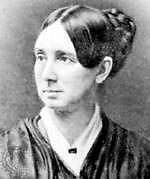|
| Affiliation | Independent |
 |
| Name | Dorothea Lynde Dix |
| Address |
, Massachusetts , United States |
| Email | None |
| Website | None |
| Born |
April 04, 1802 |
| Died |
July 17, 1887
(85 years) |
| Contributor | Thomas Walker |
| Last Modifed | Thomas Walker
Dec 10, 2005 09:59pm |
| Tags |
|
| Info | Dorothea Lynde Dix (April 4, 1802–July 17, 1887) (not to be confused with the journalist Dorothy Dix) was a tireless social activist who, from the early 1840s to well after the American Civil War, drew on the most advanced 19th century ideas about psychiatric treatment to successfully lobby almost every State legislature to create asylums for the insane. Unfortunately for her legacy, these state hospitals grew into enormous "museums of madness" that served as the deserving targets for later reformers’ zeal.
Dix was neither a physician nor a psychiatrist, beginning her career as a reformer before the first woman graduated from a U.S. medical school.
She credited her interest in mental illness to a conversation she overheard in Boston, where two gentlemen were loudly denouncing the awful conditions in the Middlesex County jail in East Cambridge. Feeling guilty about her obsessive "improvement of her mind at the expense of her heart," and bereft of family ties to provide her heart "scope for its affections," she decided to go to the jail to see if she could be of help to those in need. There she found a number of insane inmates in disgusting circumstances, which led her to approach the Massachusetts legislature to obtain an official inspection commission.
The story of how Dix came to take an interest in the mentally ill is more complex and more interesting than this legend. Surviving a childhood of abuse and neglect, she became a student of the Unitarian reformer William Ellery Channing, and began her career as a teacher and writer.
Throughout her life she appears to have turned away from several opportunities to marry. By the mid 1830s she became quite depressed. It is difficult to speculate about the reasons for her declining mood. Being ambitious and having staked so much on her career, it is plausible to see her becoming depressed as she perceived the limited opportunities available to a woman of the time as a teacher and writer. In any event, friends arranged to have her sent abroad to recover. In England, she spent a year living on the estate of the Rathbone family, eminent Quaker reformers, where she recovered.
She was quick to see the parallel between the circumstances of her recovery and the moral treatment practiced at that time in Quaker institutions for the mentally ill, such as the York Retreat. She made an intensive study of this treatment which emphasized the healing power of a family-like asylum removed from the pressures of daily life. When she returned to the United states she brought an enthusiasm for this idea with her.
By the early 1840s she began tirelessly visiting almshouses and jails where the homeless were confined. She then lobbied state legislatures to erect asylums to treat the insane according to the precepts of moral treatment.
During the Civil War she moved to Washington, DC and attempted to set up a nursing service for soldiers. Due to political infighting and her stubborn determination to do things her way, this was not a completely successful venture. After the War, although she was physically exhausted, she resumed her lobbying for the mentally ill, now by letter more often than in person. The two dozen mental hospitals built between 1865 and 1880 demonstrate the continuing momentum of her cause.
Dix lived, however, not only to see mental hospitals grow in number but also in size. It is distressing to imagine her witnessing the transformation of the hospitals she hoped would provide warm, familial care into overcrowded custodial institutions. Outliving her friends and family, she spent her last years living as a guest in the New Jersey State Hospital in Trenton.
First Appeared on a United States Postage Stamp in 1983.
Vote totals for elections in which was nominated for the Hall of Fame for Great Americans (1900-1965): 1900-12, 1905-37, 1910-29, 1915-28, 1920-31, 1925-27, 1930-7, 1940-19, 1945-2, 1950-13, 1955-10, 1960-4, 1965-1.
[Link] |
|
 |
| Date | Firm | Approve | Disapprove | Don't Know |
 | BOOKS |
 |
|
| Title |
Purchase |
Contributor |
|
| Date |
Category |
Headline |
Article |
Contributor |
|
 | INFORMATION LINKS |
|
|
|

